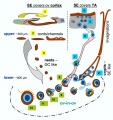File:Human- adult ovary primary follicles.jpg

Original file (600 × 639 pixels, file size: 56 KB, MIME type: image/jpeg)
Working model of possible pathways for formation of primary follicles in adult human ovaries (updated from Ref. [32]).
1) Ovarian tunica albuginea (ta) stem cells (green color) differentiate into the CK+ fibroblasts (red color) and by mesenchymal-epithelial transition give rise to the SE cells directly covering the ovarian cortex (arched arrow).
2) Closing of TA flaps (see Fig. 1) results in the formation of epithelial cords/channels in the upper ovarian cortex (see Fig. 3). Fragmented epithelial cords give rise to the epithelial nests, which resemble primitive granulosa cells [22] and descend into the lower ovarian cortex.
4) Depending on certain in situ (stromal) influences, the TA progenitors differentiate into the SE cells covering TA, which may, by asymmetric division, give rise to the ZP+ germ cells.
5) These putative germ cells may symmetrically divide, descend into the ovarian cortex, and associate with adjacent cortical vessels (6). Intravascular transport (7) is associated with a substantial increase of germ cell size and with development of ZP+ anchors (green lines), which may serve to slow down the transport speed and signal the epithelial nests to associate with a particular vascular segment.
8) The intravascular germ cells differentiating into the oocytes are picked up by epithelial nests associated with the proper cortical vessels. Such oocyte-nest complexes show an "octopus-like" (9) formations during the early stage of assembly, and a formation of the Balbiani body during the intermediate stage (yellow body,
10). The Balbiani body persists in resting primary follicles (11), but diminishes upon the growth promoting signals, including Thy-1 dp signaling derived from the follicle-accompanying vessels (12, dashed line). An alternative pathway for the germ cell origin from TA precursors (4') consists of a constitution of cortical crypts formed by SE-like embryonal type cells [22,25], possibly originating from, but not necessarily connected with, the deep SE invaginations, as evidenced from serial sections.
The "alternative" pathway of germ cell origin may supply the oocytes directly to the neighboring nests (dashed arched arrows) and, via vascular transport (dotted arched arrow), saturate distant nests to form the primary follicles.
Ref 32: Bukovsky A, Keenan JA, Caudle MR, Wimalasena J, Upadhyaya NB, Van Meter SE: Immunohistochemical studies of the adult human ovary: possible contribution of immune and epithelial factors to folliculogenesis. Am J Reprod Immunol 1995, 33:323-340.
Original File Name: 1477-7827-2-20-16.jpg
Origin of germ cells and formation of new primary follicles in adult human ovaries. Bukovsky A, Caudle MR, Svetlikova M, Upadhyaya NB. Reprod Biol Endocrinol. 2004 Apr 28;2:20. PMID: 15115550
Bukovsky et al. Reproductive Biology and Endocrinology 2004 2:20 doi:10.1186/1477-7827-2-20 http://www.rbej.com/content/2/1/20
© 2004 Bukovsky et al; licensee BioMed Central Ltd. This is an Open Access article: verbatim copying and redistribution of this article are permitted in all media for any purpose, provided this notice is preserved along with the article's original URL.
File history
Click on a date/time to view the file as it appeared at that time.
| Date/Time | Thumbnail | Dimensions | User | Comment | |
|---|---|---|---|---|---|
| current | 01:47, 18 April 2010 |  | 600 × 639 (56 KB) | S8600021 (talk | contribs) | Working model of possible pathways for formation of primary follicles in adult human ovaries (updated from Ref. [32]). 1) Ovarian tunica albuginea (ta) stem cells (green color) differentiate into the CK+ fibroblasts (red color) and by mesenchymal-epithe |
You cannot overwrite this file.
File usage
The following page uses this file: